Published
on 17
Sep 2021
|
All rights reserved.
|
|
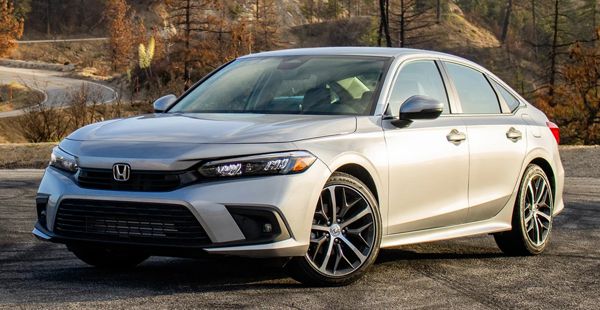
|
|
Conservative
look is the only major shortfall.
|
|
Looking back the history
of Honda Civic, you will find its styling often swings between radical
and conservative. If there is any consistency in its design philosophy,
it must be consistently inconsistent. From brand management point of
view, this is not good, as it keeps destroying the image already built.
However, influenced heavily by instant noodles and pop cultures, the
Japanese don’t care at all. They see big changes offer fresh talking
points, allowing the designers and engineers to talk how much they had
done and moved the game forward, even though sometimes it is actually
backward. Usually, motoring journalists are willing to cooperate.
The outgoing, 10th generation Civic was the radical one. Shaped like a
coupe and spiced up with some sharp edges, it looked far more
interesting than any Civics since Mk5, I would say. This time, Honda
takes a U-turn and drives to another extreme. The Mk11 Civic is
conservative. Taller, fatter, flatter and bulkier. The pointy nose and
sweeping clamshell bonnet of the old car have been replaced with a
wind-blocking nose and a bonnet so flat that can easily double as a
picnic table. Honda proudly said the base of its windscreen pillars
have been moved back by 2 inches, but it did not explain what benefits
this brings. To make the Civic like a rear-drive machine? I guess no
one would confuse. Even yes, what’s the real benefit of making a car
look like rear-drive without providing the handling advantages of
rear-drive? Does the new shape improve aerodynamics? I don’t think so.
Monospace cars like Mercedes EQS and Toyota Prius tend to return lower
drag coefficient. I guess, if Honda really managed to reduce drag with
a 2-box conservative, it would have mentioned in its press materials.

|
|
Hatchback
retains manual box, sedan not so lucky.
|
|
To make things worse, the design team gave the new Civic sedan a
comically short deck that makes the whole car look unbalanced. Still,
the sedan is better than the hatchback, whose pronounced tailgate looks
heavy yet its fast angle helps little cargo space. Perhaps Honda should
turn it to a wagon instead. Peugeot proved that wagons could be just as
stylish as sedans, provided you master the skills of styling. By the
way, the Civic hatchback used to be built exclusively in the Swindon
plant in UK. Following its closure last year, production of the
hatchback will move to the US plant (while sedan is still assembled in
Canada). Therefore, the upcoming Type R will be built in the US for the
first time.
Surprisingly, underneath the uglier sheet metal is the same platform.
While the new car is 35mm longer in wheelbase and 45mm longer overall,
key mechanical parts are carried over. These include engines (2.0-liter
NA or 1.5 turbo), transmission (CVT or 6-speed manual) and suspensions
(struts up front and multi-link rear). Still, Honda found plenty space
for improvement. For example, by using structural adhesives and
additional reinforcement points, the chassis gains 8 percent torsional
rigidity. Small they might sound, but on the road you can feel the
improved NVH suppression. The front suspension gets low-friction
ball-joints and damper mounting bearings to improve steering feel. The
rear suspension gets slightly wider track to improve roadholding and
larger bushings to cut harshness. Urethane spray foam is applied to
hollow areas of the body to kill noise.
The entry-level 2.0 i-VTEC engine is exactly the same as on the old
car. It produces 158 horsepower and 138 pound-foot of torque, the
latter is on the low side by today’s standards, especially at lower
down the rev. The “Earth Dream” 1.5 turbo used to employ only variable
cam phasing, but now it has added VTEC variable valve timing and lift
to the exhaust side, like the one serving Accord. In addition to
improved turbo plumbing and a freer exhaust, output is lifted by 6
horsepower to 180, while peak torque increases from 162 to 177 lbft.
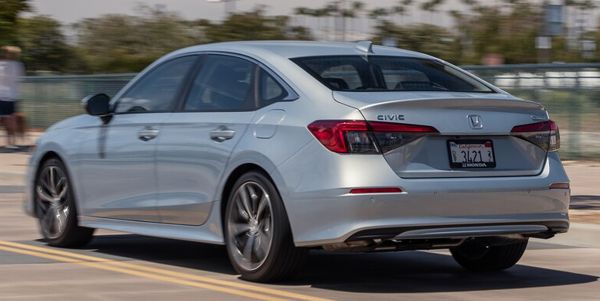 |
|
All-round
dynamics is guaranteed.
|
|
Even so, performance has taken a backward step like the styling. Car
and Driver found the 1.5T taking 7.5 seconds to do 0-60 mph sprint,
compared with 6.8 seconds of its predecessor. Although 7.5 seconds is
still pretty quick for a regular family car, it is no longer as
special. No one has put timing gears to the 2.0-liter base model yet,
but expect a similar drop in performance to around 9 seconds. Why
slower? The new car has gained about 50kg, yet its fuel economy is
improved by 1 or 2 mpg, which implies a more economy-oriented setup of
its engine and transmission mapping.
Speaking of transmission, the mass-selling Civic sedan has killed off
manual transmission this time around – although it is still available
on the hatchback – leaving only a CVT to serve all people. We hate
CVTs, of course, but the one on Civic is undeniably better than what we
used to see, because “rubber band effect” is limited to initial
acceleration, after which the ratio is locked, so the thrash comes
down. Still, CVT is a cheap alternative to a torque converter automatic
and no replacement to a good old manual. On the weaker engine, the CVT
needs to work harder thus refinement remains a weak point.
However, unless you push the engine too hard, you can enjoy high
refinement in the new Civic. The engine is well isolated from the
cabin, ditto other noise sources. The ride quality is especially
appreciable, as it is smooth and quiet yet has an underlying firmness
like Volkswagen, keeping body roll well checked. The steering is
predictably light, but accurate and linear in response. Ditto the
throttle and brake pedals. Overall, the Civic is not as entertaining as
Mazda 3 or Ford Focus, but certainly handles better than its main
rivals Toyota Corolla and Hyundai Elantra, while offering more ride
comfort and refinement as well.
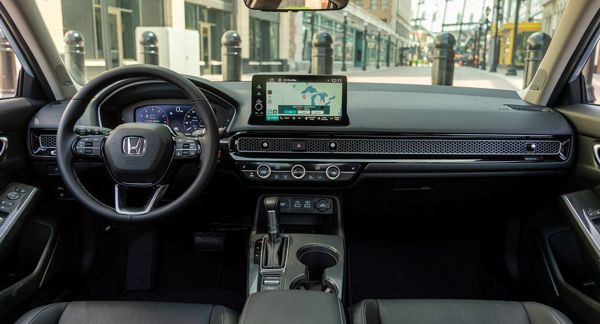 |
|
Interior
looks far more upmarket.
|
|
The biggest improvement is probably the interior. We criticized the old
car’s cabin for its cheap plastics used in center console and
transmission tunnel, as well as its angular and busy design that didn’t
help quality perception. Honda has listened to criticisms and worked
harder this time. The interior styling and build quality have been
lifted markedly, at least how it is perceived. Its dashboard is mounted
lower to feel more airy. Slimmer A-pillars, lower cowl and waistlines
also improve outward visibility and sense of spaciousness. Unusually, a
honeycomb mesh accent spans the full width of the dashboard to spice up
the style and give a luxury feel. It covers the vents, so you adjust
the vents using joysticks, which is another novel feature – just wonder
how to clean the dirt gathered at the mesh. Yes, the Civic employs
plenty of hard plastics to keep its price affordable, but they are
grained and rarely come into touch. The transmission tunnel is covered
with a metallic plastic panel that doesn’t catch fingerprints like the
popular choice of gloss black. Such attention to details is worth
praising.
A conventional instrument pod looks a bit outdated these days, but it
is necessary to accommodate an analogue dial in the base model. After
all, the Civic starts at just under $23,000, not a $50,000 EV. Higher
spec. models get a full-digital instrument (which still doesn’t fit the
instrument pod fully) and has the 7-inch center touchscreen upgraded to
9-inch item, both incorporate some physical buttons and rotary volume
knob for easier access. Likewise, Honda keeps the rotary switch for
climate control. The infotainment system is well designed, while
smartphone connectivity and wireless charging are standard.
While space is virtually unchanged from the old car, it is still one of
the roomiest in the class. Not many compact family cars can take a 6ft
3in passenger behind a driver of the same size with space to spare.
All in all, the new Civic is a solid player that offers superb comfort
and fine dynamics. Practicality and value for money remain a strong
card. Although the conservative exterior is hard to love, the more seat
time may change your view.
|
Verdict:     |
Published on 22
Dec 2021
|
All rights reserved.
|
|
Civic Si
|
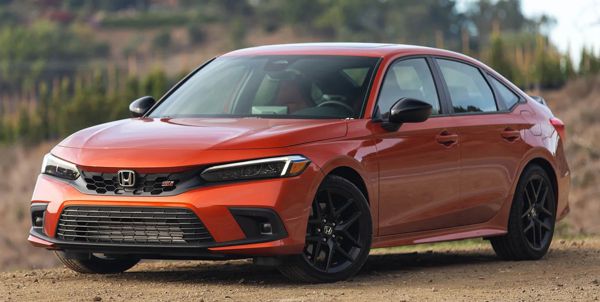
|
|
Drives
better than it appears.
|
|
Civic Si has always been a
performance compact car designed for the North American market. Sitting
under Type R, it is Honda’s version of Golf GTI. Our fondest memory of
the Civic Si was associated with the legendary K20 VTEC engine, which
produced about 200 horsepower and propelled the Si from zero to 60 mph
in 6.8 seconds. Back in 2006, that was a pretty fast car for
entry-level budget.
Unfortunately, since then the Civic Si seems to be content of the same
performance. The latest Si still produces 200 horsepower, but that
comes from a 1.5-liter turbo engine instead of a naturally aspirated
VTEC. The last generation from 2017 was, too, but it made 205 ponies.
Honda did not explain why the new version loses 5 hp, just said it has
a broader spread of torque, with the same peak torque of 192 lbft
produced between 1800 and 5000 rpm instead of 2100-5000 rpm. The peak
output is moved 300 rpm up to 6000 rpm. Yes, it feels a tad more
tractable low down, but hard to tell if it is more eager to visit
redline, which is set at 6500 rpm, not the VTEC’s 8000 rpm. Being a
highly boosted small turbocharged engine, it feels strained at the top
end from the way it sings (or protest). This isn’t a match to
Volkswagen’s 2-liter EA888, which is not only sweeter but also a lot
more powerful and flexible.
As a result, the new Si is a tad slower in acceleration, taking 6.8
seconds to go from 0-60, or about half a second slower than before. In
fact, it is no quicker than the 2006 version.
At least a lighter flywheel helps improving throttle response, while
the combination of a light clutch and a world-class manual gearbox is
still a strong reason for keen drivers to choose the Civic Si.
Gearshift of the 6-speed unit is slick, short and mechanical. The gear
throw has been shortened by a further 10 percent to make it feel even
snappier. It is one of the very few manual boxes that you will love
shifting for the sake of it. Besides, automatic rev-matching function
has been added. What the new Si loses in numbers, it pays back in
quality.
The chassis is similar. Objectively, it is hardly remarkable. Cornering
grip, braking distances and lap times are all no better or even a bit
worse than its predecessor, but the stiffer monocoque and improved NVH
suppression of the new Civic returns a more substantial feel to the
driving experience. The steering weighs up nicely in corner and
delivers decent feel. Adaptive dampers of the old car have been
discarded on the ground of cost cutting, but stiffer suspension setup
makes up, keeping body movement in check and resisting understeer well.
Although the ride gets stiffer than the old car in comfort setting,
harshness is largely absorbed by the chassis, so there is not much to
regret. The standard LSD keeps the nose biting. Only the brakes feel
not up to the job, could easily fade after a few high-speed stopping.
Inside, the Si shares the standard car’s much improved build quality,
style and ergonomics, as well as better visibility achieved by the
upright windscreen and slimmer pillars. Space and practicality remain
its strengths. The heavily bolstered bucket seats are the only upgrade
it gets. Overall, the new Si is a slightly better car as a whole, but
it cries for a better engine, brakes and exterior design to challenge
Golf GTI.
|
Verdict:    |
Published on 29
Nov 2022
|
All rights reserved.
|
|
Civic e:HEV
|
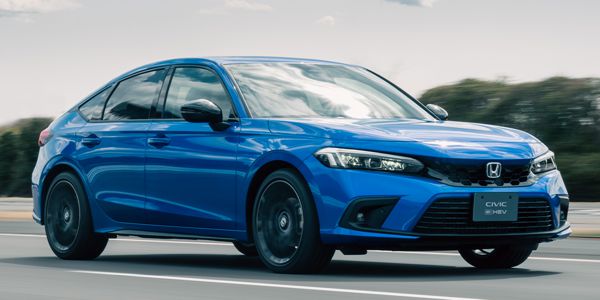
|
|
After
3 failures, hybrid Civic finally takes off.
|
|
Honda did not produce a
Hybrid version of the last generation Civic, but prior to that, it
built Civic Hybrid in 3 successive generations, all powered by the
unsuccessful IMA (Integrated Motor Assist) hybrid system. IMA paired a
small petrol engine with a disc-shape small electric motor which
doubled as generator during braking. Its electric power was weak,
needed the petrol engine to work most of the time, if not always, so
fuel economy was not as good as advertised in real world situations.
Consequently, it lost to Toyota in the hybrid competition.
Now the hybrid Civic returns, but it has switched to a new hybrid
system called e:HEV. This consists of a larger, 2.0-liter
Atkinson-cycle and direct injection 4-cylinder engine, a CVT and 2
electric motors. One motor works as propulsion motor while another as a
generator, so their design could be optimized for their purposes. The
engine produces 141 horsepower, well above the 90 horsepower figure of
the last Civic Hybrid’s 1.5-liter 8-valver. But most important, the
propulsion motor produces 184 horsepower, versus merely 23 hp of the
old car. The electric motor is also remarkably torquey, giving 232
pound-foot of torque.
The way the hybrid system works is also very different from before. In
fact, for most of the time it is a series hybrid system, like Nissan’s
e-Power (see Nissan Note).
This means, in hybrid operation mode the engine does not drive the
wheels directly, but is used to turn the generator motor, which
supplies the propulsion motor and drives the front wheels. This
indirect propulsion is usually more efficient in most driving
situations, because the engine can work at steady rev regardless of
vehicle speed. The battery can supplement if more power is in demand,
or conversely, if there is surplus power from the engine, can be used
to recharge the battery. At lower speeds where not much power is
required, the Civic works in EV mode until battery runs out. Only at
highway cruising where the engine rev is constant, a clutch will engage
the engine to the CVT and drive the front wheels directly, so to
minimize the loss in between. Because of such arrangement, its maximum
system output is equivalent to the propulsion motor’s output, i.e. 184
hp and 232 lbft. The result is a quite remarkable performance: 0-60 mph
takes only 7.5 seconds, although top speed is limited to 112 mph.
On the road, the e:HEV blends the two power sources seamlessly.
Transitioning from electric power to series hybrid power is very
smooth. Only in full-effort acceleration the engine will make you aware
of its work audibly, yet the noise is not too intrusive. The CVT is
also well configured such that rubberband effect is rectified, no doubt
thanks to the thick torque. As a result, the car feels brisk and
responsive yet refined. As for fuel economy, it beats the equivalent
Toyota Corolla 2.0 Hybrid narrowly, something none of its predecessors
could dream of.
The rest of the car is the same story as other Civic models. It drives
much better than it looks. Steers well, rides well and controls its
body well, especially as the e:HEV is tuned for Europe thus gets
stiffer suspension setup. The cabin is roomy and nicely finished. Feels
rigid and refined on the move, too. The hybrid’s battery is only 1.05
kWh, so it fits neatly under the rear seat and takes no luggage space.
What a pity the Civic looks so dull.
|
Verdict:     |
Published on 23
Dec 2022
|
All rights reserved.
|
|
Civic Type R (FL5)
|
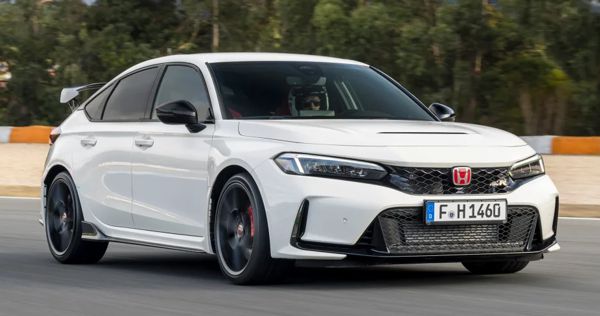
|
|
Old
wine in new bottle? If the wine is so fine, why not?
|
|
This is the 6th generation
Civic Type R, built on the 11th generation Civic. The evolution of this
car shows how far the hot hatch world has gone. Remember the original
EK9? A really compact car powered by a 9000-rpm 1.6-liter VTEC motor.
You need to squeeze out every rev to feel quick, but the process was
immensely fun. In 20 years’ time, the CTR gets 2 sizes larger and
300-odd kilograms heavier, 5 doors instead of 3, and the motor became a
2.0-liter turbo with 320 horsepower, plus a lot of mid-range torque.
Fortunately, the car has not gone soft. On the contrary, it gets
sharper and better, finally rising to the top of the hot hatch class in
the view of keen drivers. In the past 5 years, nothing else could quite
threaten its domination, especially after the mighty Renaultsport
Megane RS275 retired.
Mechanically, the latest Civic Type R, codenamed FL5, isn’t remarkably
different from the outgoing FK8. Its engine, gearbox, suspension,
steering and brakes are all carried over, although subtly improved. The
biggest change is the new body shell, defined by the latest Civic, of
course. Unfortunately, that is also the biggest drawback of the car, as
it looks conservative and boring, lacking any sense of firepower and
speed. If not the huge rear spoiler, it doesn’t look like a performance
car at all. It might be the dullest CTR of all in its 25 years history.
On the plus side, the new Civic body shell is larger than ever. Its
2735 mm wheelbase falls into mid-size family car segment, while the
1.9-meter width also challenges our definition of “hot hatch”. This
lends the new Type R a roomy back seat and generous cargo space.
Another big improvement is the finish of the interior, which feels
high-quality and upmarket, if not up to the level of Mercedes or BMW's
small cars.
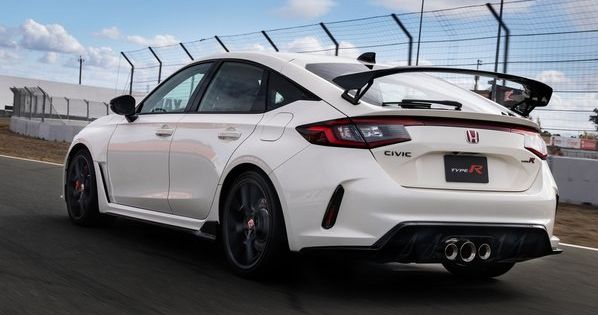
|
|
Beautifully
tuned controls and interactive chassis put it above its peers.
|
|
By using more structural adhesives, the body structure is 15 percent
stiffer than the old Civic Type R. The 15 mm wider tracks enhance
handling, while 35 mm stretch of wheelbase helps ride comfort. Honda
gives it an aluminum bonnet and resin tailgate, but the new car still
gains 50 kg over its predecessor, now tipping the scale at 1430 kg.
Therefore, it needs more power. The K20C1 motor is basically unchanged,
still employs goodies like sodium-filled exhaust valves, piston-cooling
oil jets, forged steel crankshaft, forged con-rods, dual-variable cam
phasing and VTEC variable lift at the exhaust valves, which helps
spooling up the turbo at low revs, but it gets a freer flowing exhaust
and a modified turbocharger with lower inertia turbine. The result is
10 extra horsepower and 15 more pound-foot of torque. 330 horsepower
arrives at 6500 rpm, while 310 lbft of torque flats out at 2600 to 4000
rpm. In other words, the linear character of the engine is unchanged,
just delivers a little bit more across the rev.
Likewise, Honda keeps the excellent 6-speed manual gearbox together
with its great-looking aluminum gear knob and rev-matching function. It
just reworked the details like shift gate pattern and spring rate to
improve the precision and feel further. A lighter flywheel improves
throttle response and helps rev matching more quickly.
As for chassis, there is no need to alter the proven dual-axis front
suspension, multi-link rear axle or the standard adaptive dampers,
because the stiffer chassis already yields 16 percent higher camber
rigidity, meaning the suspension geometry can sustain higher cornering
load. To improve roadholding, Honda stiffens the springs and dampers,
while downsizing the forged alloy wheels from 20 to 19-inch to cut
unsprung weight thus compensate the loss in ride comfort. By widening
the rubbers from 245 to an unusual 265 mm, contact patch area is
actually enlarged by 8 percent, and I am sure the Michelin Pilot Sport
4S tires must generate more grip than the old car’s Continental
SportContact 6. You may even opt for Cup 2 tires now, if you are really
keen on track days.

|
|
10
more horsepower offset by 50 kg more weight means unchanged straight
line performance. Gearshift greater than ever though.
|
|
The steering keeps variable-ratio rack geared to 2.1 turns from lock to
lock, but a stiffer torsion bar should give more feedback. The Brembo
brakes are unchanged, as Honda found they have no problems to deal with
the extra weight. However, brake cooling is improved, so it should cope
with track work more easily.
Lastly, the dull-looking body shell is actually better in aerodynamics.
Top speed has risen by 2 mph to a Porsche-like 171 mph, which is very
un-hot-hatch. Simultaneously, downforce increases by about 100 kg at
124 mph – yes, it is still one of the very few hot hatches that produce
positive downforce.
On the Road
The new Civic Type R might look dull, especially up front, but once you
have settled in the cockpit, everything feels right – the trademarked
red bucket seats are supportive, grippy yet comfortable for long
journey. The driving position cannot be more correct. Pedals, steering
wheel and gear lever are all found at the right position. The alloy
gear knob feels perfect in hand, as is the Alcantara-trimmed steering
wheel. This car is built by someone who really loves driving.
Visibility is very good, too. Even the huge rear wing doesn’t hamper
rearward view, as it is mounted high enough. The dashboard design is
not especially attractive, but the materials feel great, fit and finish
is flawless. The rear seat is restricted to 2, as it is split by cup
holders, but those 2 get massive legroom and plenty of headroom. Behind
them is 470 liters of boot space, expandable with rear seats down. This
is not just a hot hatch, but a decent family car for everyday use.
Honda’s turbocharged motor might lack an inspiring soundtrack, but its
power delivery is remarkably linear. The higher it revs, the stronger
it feels, encouraging you to use its full 7000 rpm spectrum. Although
there is a little bit turbo lag low down, throttle response is keen.
Unlike so many turbocharged motors that work well at the mid-range but
reluctant at the top end, the Honda motor is always smooth and
enthusiastic to rev beyond its 6500 rpm power peak. If Ferrari builds a
turbocharged four, it might be like this.
The wonderful gearshift enhances the joy further – snappy and precise,
so enjoyable that you will turn off the rev-matching function just to
enjoy the full experience.

|
|
If
Porsche’s GT department builds a hot hatch, it might be like this.
|
|
Inevitably, sticking with manual gearbox means sacrificing outright
performance. Ditto front-wheel drive. Although the CTR feels quick, it
is actually no quicker than the last generation. 0-60 mph takes just
over 5 seconds and 100 mph is reached at more than 12. A Volkswagen
Golf R, benefited by 4WD and DSG gearbox, is a full second and 2
seconds quicker, respectively. It goes without saying super hot hatches
like Mercedes A45S and Audi RS3 are faster still.
However, the CTR is designed to excel in a road course like Nurburgring
or a race track. Its aero, its roadholding, its balance and precision
all point to an outstanding handling. Its controls are so well tuned
that the steering, the braking and the drivetrain work all in a piece.
The chassis is so predictable and well balanced. Although the Type R
offers massive grip, it is not all about cornering on rails. Push it to
the apex and it understeers gently. Back off throttle abruptly and it
tugs its nose into corner. Hit the brake hard and its tail swings out a
little, even with stability control left in place. Such an interactive
and consistently predictable chassis are rare in the hot hatch field
now, and definitely no one operates at such a high performance level
and in a manner so reassuring. The CTR’s stiff body shell and its
ability to absorb bumps without distorting suspension geometry is one
of the causes to praise. Mid-corner bumps fail to shake its chosen
line. If Porsche’s GT department builds a hot hatch, it might be like
this.
Undoubtedly, the Civic Type R is engineered by someone who are really
hardcore drivers, more so than the N division of Hyundai. It is not
remarkably different from the last generation, but the concept is
further polished and improved to deliver even greater results.
Downside? Apart from looks, its ride is quite hard, noticeably harder
than the old car. It renders the Sport and R+ mode to useless on normal
road driving. Fortunately, an Individual mode allows you to set the
dampers to Comfort mode and the rest of the car to Sport or R+ mode,
which is the most sensible combination.
Besides, the new car gets very expensive. When the last generation
arrived 5 years ago, it started from $35K in the USA and £31K in
the UK. Now the entry price balloons to $44K and £47K,
respectively, which is no longer a bargain. A Golf R and AMG A35 are
slightly cheaper at £43K and £44K, respectively, while
Hyundai i30N (£34K) and Ford Focus ST (£35K) are
significantly so. Admittedly, none quite offer the same lap
performance, overall ability and thrills as the Honda. While Audi RS3
and AMG A45S are much quicker, they charge even more (£51K and
£61K before thick options). Toyota GR Corolla Circuit pack could
be its stiffest rival at the moment, which charges $43K in the US
market. However, the fact that Honda dares to charge so much for the
new CTR reflects exactly its superiority over any other cars in its
class, as no one can quite challenge it, at least in the front-wheel
drive hot hatch world.
|
Verdict:      |
|